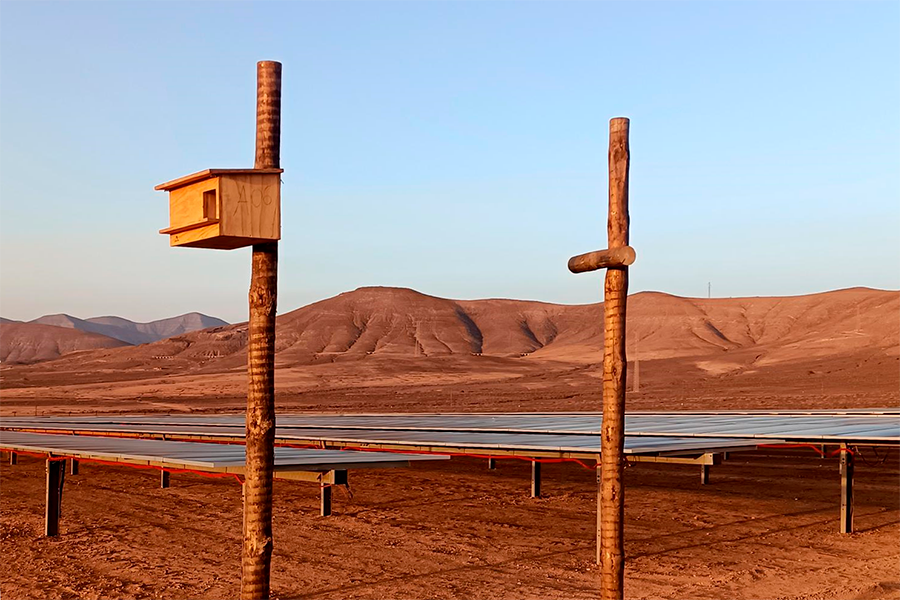Llanos Pelaos III photovoltaic project receives the UNEF Seal of Excellence for Sustainability 2023
- The Llanos Pelaos III project is located in Puerto del Rosario (Fuerteventura), and has 7 MW, enough capacity to supply 4,000 homes with clean energy.
- The modules will jointly produce renewable electricity that will prevent the emission of 7,000 tonnes of C02 per year into the atmosphere.
- Iberdrola España has built shelters for insects, reptiles and micro-mammals, such as rodents, hares, rabbits and bats, among others. It has also placed nesting boxes and perches for birds

Iberdrola España has built nesting boxes and perches for birds in the park, as well as shelters for insects, reptiles and micromammals.
The Llanos Pelaos III photovoltaic plant, built and operated by Iberdrola España on the island of Fuerteventura, has become the thirty-seventh project to obtain the UNEF Seal of Excellence for Sustainability, which recognises ground-mounted solar power plants built with the highest social and environmental integration criteria. It is the first project to obtain this certification in the Canary Islands.
Llanos Pelaos III is the fourth Iberdrola España project to achieve this certification, for which an independent audit was carried out by the company SGS, in which socioeconomic, biodiversity preservation and restoration and circular economy parameters were assessed, in line with the company's commitment to economic, social and environmental sustainability.
The Seal of Excellence in Sustainability, which was created by UNEF in 2020 to disseminate the good practices of the Spanish photovoltaic sector, reinforcing the commitment of the national photovoltaic sector to a sustainable energy transition. Continuing with this work, UNEF has become the first entity worldwide to design its own system for the certification of the sustainability of photovoltaic installations, aimed at all companies that may be interested in obtaining it, whether they are developers, builders, owners or any others in the ground-mounted solar plant segment.
Consuelo Álvarez, Iberdrola España's representative on the UNEF Board of Directors, adds that "Seals like this one give us the impetus to continue making our facilities true places where social, environmental and territorial coexistence is possible. For years Iberdrola España has been working within the Convive Programme on a multitude of initiatives to promote these good practices".
"These projects demonstrate that there is no source of energy generation more integrated with the territory, biodiversity and citizens than solar energy. We are convinced that, thanks to the existence of this pioneering certification, what seems to be the exception will become the norm in the national photovoltaic sector. In the coming years, we are confident that all ground-mounted solar energy projects will have and will see their excellent standards of social and environmental integration recognised", Donoso emphasised.
About Iberdrola España's Llanos Pelaos III project
The Llanos Pelaos III project is located in Puerto del Rosario (Fuerteventura), and has 7 MW, enough capacity to supply 4,000 homes with clean energy, which is equivalent to a town like Valle del Gran Rey in La Gomera.
The installation, which is connected to the distribution grid, consists of 12,700 tracker modules. This system maximises energy collection by allowing the modules to move along the path of the sun. The modules will jointly produce renewable electricity that will prevent the emission of 7,000 tonnes of CO2 into the atmosphere per year.
Llanos Pelaos III has been developed together with the companies IASOL and Energy Projects and Investment Capital, which have a minority shareholding. The project, built with local companies and suppliers, has involved an investment of €7 million and has generated 35 jobs during peak periods, contributing to the revitalisation of the industrial fabric.
Both in the planning and development of the photovoltaic park, the Spanish company has carried out different measures to protect the environment and biodiversity that will continue during its commissioning. The company has built shelters for insects, reptiles and micro-mammals, such as rodents, hares, rabbits and bats, among others. It has also placed nesting boxes and perches for birds.
